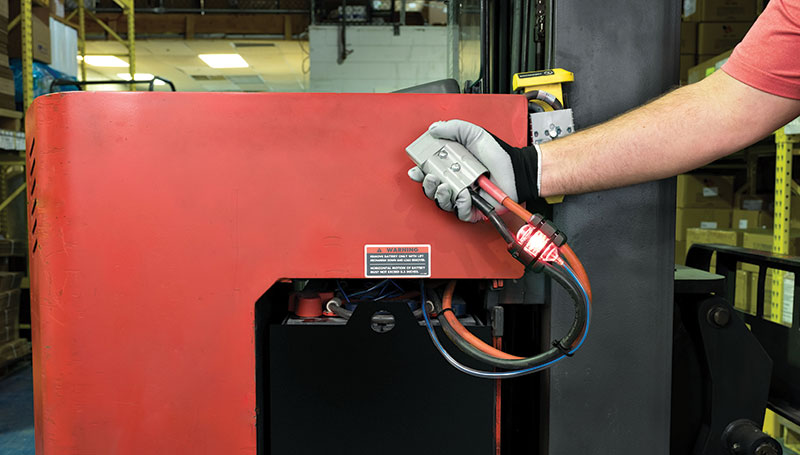The connected lift truck battery
As the fulfillment environment becomes increasingly connected, the lift truck battery has become a new focal point for companies that want to get the longest life and usage out of their investments.
Whether they’re connecting their Apple watches and iPhones to review the last month’s physical activity, using sensors to collect and transmit data about machine usage, or monitoring activity at their properties while away from home, people are more “connected” than ever thanks to the proliferation of Wi-Fi-enabled smart devices.
With about 20 billion Internet-connected things now in place, according to a Gartner Research report, it makes sense that lift truck batteries would join the fray—and they have in full force. According to the manufacturers interviewed for this article, the race is on to develop batteries that connect to sensors and software to help reduce downtime, improve performance and enhance throughput.
At Green Cubes Technology, Robin Schneider, director of marketing, says that monitoring is a core focus for battery makers right now. In the past, lead acid batteries used a battery management device (BMD) that was attached to a charger and used to monitor performance. The process took about three to five minutes to complete (per battery) and could only handle one battery at a time.
Lithium-ion (Li-ion) batteries, on the other hand, use a battery management system (BMS), which at a minimum must provide a number of safety features for the use of Li-ion, but they also monitor the battery’s state of charge, health and communications. “A BMS enables the battery itself to communicate to the outside world about how it’s being used and its performance,” says Schneider. “In this ‘first generation’ of battery monitoring, people can log in locally (using a local hot spot) and monitor everything within that hot spot location.”
A warehouse manager, for instance, could monitor all lift truck batteries at a specific location or remotely, the latter of which Green Cubes recently added to its products. “We can look at batteries nationwide across different users, locations and vehicles,” Schneider explains, “and then monitor the battery usage and utilization for that equipment.”
This not only helps pinpoint failure points and other problems, but it also allows warehouse managers to troubleshoot remotely. “The information is so detailed,” she adds, “that it allows us to examine each battery cell individually.”
Key drivers
Dean Portney, vice president of sales and marketing at Hawker, says the connected battery trend is largely driven by the introduction of lithium-ion batteries, whose chemistry requires finite monitoring by a battery management system in order to deliver the highest level of safety. “Many lift truck OEMs require communication between lithium batteries and their trucks to ensure optimal performance, safety and delivery of the longest economic life out of the battery,” Portney explains.
And while Hawker has been using wired devices to monitor its batteries for about 15 years, he says the “sophistication and requirements of new [battery] chemistries deliver superior performance and longevity with good communication.” Considering the growing popularity of lithium-ion batteries, many battery manufacturers have also designed battery management systems (BMS) that communicate with the lift truck using a CAN communication protocol.
Looking ahead, Portney expects interest in connected lift truck batteries to increase as companies strive to do more with less in the fulfillment environment. Being able to monitor batteries and chargers remotely from a smart phone or tablet, for example, means easier predictive maintenance, budget management and problem identification. “This is especially useful for companies that have to monitor that activity across multiple locations,” says Portney.
Extending battery life
According to Schneider, early adopters of connected lift truck batteries tend to be in the cold storage space (namely, food and beverage), where lithium-ion batteries and remote monitoring are both welcome changes in these harsh environments. To switch out a lead acid battery, for example, you need space and time, both of which come at a premium in the cold storage environment. Operators also need time to stabilize the battery temperatures in and out of the cold storage area.
“This is an environment where there’s a lot of advantage to just keeping the battery and the charger in the cold storage and then monitoring it remotely,” says Schneider, who points to the popularity of home grocery delivery and meal kit providers like Hello Fresh as two other key drivers of connected lift truck battery usage. “These are [sectors] where companies are seeing the highest ROI as early adopters of connected battery technology.”
For companies of any size, changing batteries on an electric lift truck is time consuming and, when not performed correctly, can significantly shorten that battery’s run time and life. “The bigger the battery room, the more confusing it becomes, and the more expensive the problems become,” says Steve Schubring, director of sales at Philadelphia Scientific.
He says the company’s Intelligent Battery Organizing System (iBOS) monitors more than 50,000 chargers worldwide and provides customers with a plethora of data points and intelligence they can use to make good decisions about their equipment. “We’re giving them metrics that range from availability to management to connect voltages to charge reintegration,” Schubring says.
Using Philadelphia Scientific’s battery management system in place, companies can eliminate the guesswork and also save money. Because it ensures proper battery rotation—which is critical to longer battery life and maximum run time—iBOS also enables more cost-effective utilization of a pool of batteries.
Continuous scanning and reporting
Pressed to do more with less, today’s warehouse and DC managers need all the help they can get when it comes to getting the most value out of their existing equipment. Lift trucks are no exception to the rule, and batteries serve as the lifeblood for these fulfillment center workhorses.
Knowing this, Dave Bollinger, technical director at Ecotec, says connected batteries help to ease these pain points by keeping operators and managers informed about battery usage, remaining useful life and other key indicators.
In 2020, Ecotec introduced the GET system, which continuously scans for battery information and uploads the data to a Cloud server. Operators and managers can then use that information to address issues, track usage, and plan for upcoming maintenance and repairs more proactively.
“It can be hard to tell when a battery is nearly worn out; you can’t look at it and make that determination,” says Bollinger. “A battery can appear to be in really good condition and even if it’s properly cared for, still be near the end of its life.”
Through connected technology, warehouse managers can “virtually” peel back the layers on this vital piece of equipment and get more proactive about maintenance, repair and replacement. “Using this knowledge, they can get their capital equipment expenses properly scheduled into their budget cycles,” says Bollinger, “versus having it be a ‘surprise’ expense.”
Bollinger says the early adopters tend to be larger corporations that have multiple locations and large lift truck fleets to monitor. “They’re trying to understand what equipment they have, where it is and how it’s being used,” says Bollinger. Along with disrepair and overutilization, the system can help detect underutilization and help managers be more proactive about how they allocate vehicles across different physical locations. “The corporate office can look around at the company’s other facilities and find out they really don’t need to purchase any more lift trucks,” Bollinger says. “They just need to move them from one location to another.”

Using a battery management system, companies can eliminate the guesswork and also save money.
It’s all about the data
According to Tim Wittig, general manager of motive power specialty at EnerSys, the heart and soul of the connected lift truck battery is the data that keeps operators and management teams informed about battery and charger activity.
“Operators get the feedback that they can use to be productive during their shifts,” said Wittig, “while management better understands how equipment’s being used and can plan ahead for potential replacements or downtime (due to a fault with the battery or charger).”
Like other battery manufacturers, EnerSys continues to roll out new hardware along with applications like E Connect, a software-driven application that supports interconnectivity between the battery and the charger, and then feeds that information back to an operator with a mobile device. It uses Bluetooth and Enersys Wi-iQ battery monitoring devices (or chargers), and then displays that operating data on the mobile device.
The information is then uploaded to the Cloud and used to take any necessary corrective actions. “We can take corrective actions from a distance,” says Wittig, “and don’t necessarily have to be onsite to understand what’s going on with the health and state of charge of the battery, or with a charger’s charge profile.” This not only helps minimize downtime, but it also helps ensure that EnerSys dispatched the right level of support for specific problems (for example, equipping a technician with the right equipment to fix a battery quickly).
Wittig says this data-centric approach helps push companies out of reactive mode and allows them to be more proactive. This, in turn, can lead to significant cost and time savings during the life of a battery. Going forward, he expects more lift truck manufacturers to embed smart tools in their vehicles with a particular emphasis on tracking and understanding equipment utilization.
“We’re also going to see CAN communication start to occur between our battery devices that are already set up for CAN communications,” says Wittig. “That will allow us to physically ‘hook’ a communication wire back to the lift truck, transmit information through the vehicle’s dashboard, and begin to integrate battery information with the lift truck information.”

Article Topics
Energy News & Resources
EnerSys showcases IP54-rated charger Stoecklin Logistics introduces new company CEO Delta showcases wireless charging solutions and machine vision solutions for smart logistics CaPow’s power-in-motion solution eliminates charging downtime Plug Power completes first Installation of electrolyzer at Amazon fulfillment center Concentric acquires Jantech, provider of uninterruptable power solutions Wiferion’s wireless charging business acquired by industrial power supply provider PULS More EnergyLatest in Materials Handling
Geek+ and System Teknik deploy PopPick solution for pharmacy group Med24.dk Beckhoff USA opens new office in Austin, Texas Manhattan Associates selects TeamViewer as partner for warehouse vision picking ASME Foundation wins grant for technical workforce development The (Not So) Secret Weapons: How Key Cabinets and Asset Management Lockers Are Changing Supply Chain Operations MODEX C-Suite Interview with Harold Vanasse: The perfect blend of automation and sustainability Consultant and industry leader John M. Hill passes on at age 86 More Materials HandlingAbout the Author
Subscribe to Materials Handling Magazine

Find out what the world's most innovative companies are doing to improve productivity in their plants and distribution centers.
Start your FREE subscription today.
April 2024 Modern Materials Handling

Latest Resources












